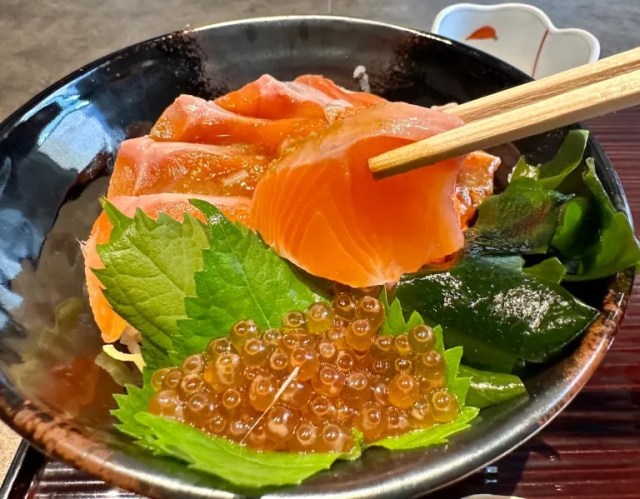
That might look like salmon, but it’s actually Fujinosuke.
We recently took a ride on Yamanashi Prefecture’s Fujisan View Express, one of the coolest sightseeing trains in Japan. With a sleek and stylish exterior, retro-chic interior, and, most importantly, amazing views of Mt. Fuji as you travel down the tracks, the Fujisan View Express is well worth riding all the way from Kawaguchiko, the first stop on the Fujikyuko Line, all the way to Otsuki Station at the other end.
Our day trip ran into just one snag, though. The Fujisan View Express doesn’t run as frequently as the regular trains do, so when we arrived at Otsuki Station to start our trip back towards Tokyo, we found out that we had an hour to wait until the next Fujisan View Express would be departing. This turned out to be a blessing in disguise, though. Give us an hour of time to kill, and our instinctual reaction is “OK, may as well go get something to eat,” and that line of thinking led us to an opportunity to try a special local kind of sashimi that we’d never eaten before.
Now, if you know much about Japanese geography, you might be raising your eyebrows at the idea of Yamanashi having its own representative sashimi, since it’s one of the few landlocked prefectures in Japan. But after we sauntered into the restaurant Hamanoya, located across the street from Otsuki Station, and opened their menu, we saw that they were offering a kind of fish called Fujinosuke.
▼ Hamanoya is the building on the left
So what is Fujinosuke? It’s a cross between king salmon (which is called masunosuke in Japanese) and rainbow trout, first bred by the Yamanashi Prefecture Fisheries Center in 2019 and now aquaculture-raised.
As a new, and regional, fish, Fujinosuke isn’t easy to find. We weren’t going to let this opportunity pass us up, so even though Hananoya’s 2,200-yen (US14.70) Fujinosuke Bowl set is more than we usually spend for lunch, we ordered one to see what this mysterious fish tastes like.
We felt better about that price point when our server placed our lunch in front of us, though. Fujinosuke is beautiful, with a vivid orange color and an enticingly glossy shine.
Accompanying the fish and rice in the bowl is a leaf of shiso, an aromatic herb sometimes referred to as “Japanese basil,” and what at first glance might look like ikura/salmon roe. Actually, though, these are masuko, or salmon eggs.
With such a gorgeous appearance, we now had high hopes for the Fujinosuke’s flavor, so imagine our joy when it turned out to taste even better than it looked! The fish has a smooth surface and a texture that gives way from firm to just chewy enough as you bite into it, and it has the optimal amount of fat to give it a rich flavor without being oily. Meanwhile, the masuko are smaller in size than ikura, but surprisingly filling, with a clean finish.
In fact, the Fujinosuke was so good that we actually wound up feeling grateful for the hour wait we had for our train. Had it been shorter, we might have been tempted to just grab some snacks from a kiosk or convenience store, and almost certainly wouldn’t have gone looking for sashimi in the mountains. So while the world-famous punctuality of Japanese trains usually means it’s a waste of travel time to get to the station very far ahead of time, if you’re passing through Otsuki, we recommend getting to the station an hour before your train leaves so that you can try the Fujinosuke too.
Restaurant information
Hamanoya / 濱野屋
Address: Yamanashi-ken, Ostuki-shi, Otsuki 1-3-3
Open 11 a.m.-9 p.m.
Website
Photos ©SoraNews24
● Want to hear about SoraNews24’s latest articles as soon as they’re published? Follow us on Facebook and Twitter!
[ Read in Japanese ]

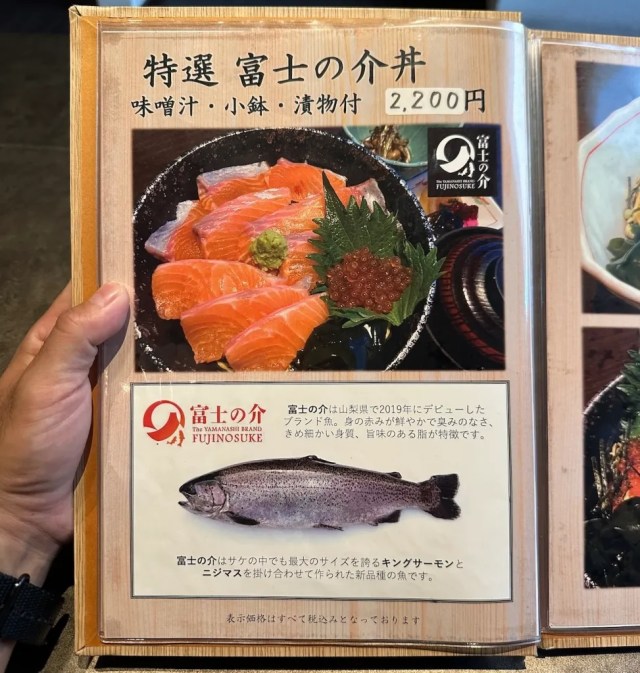
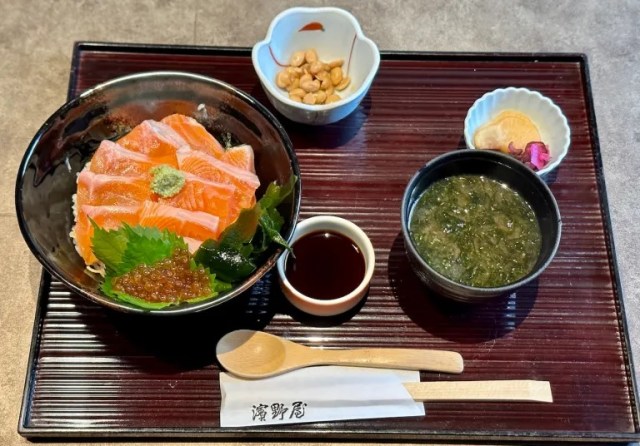

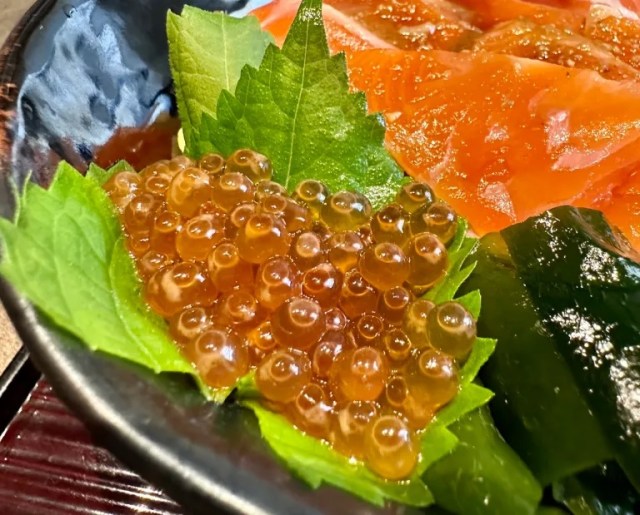
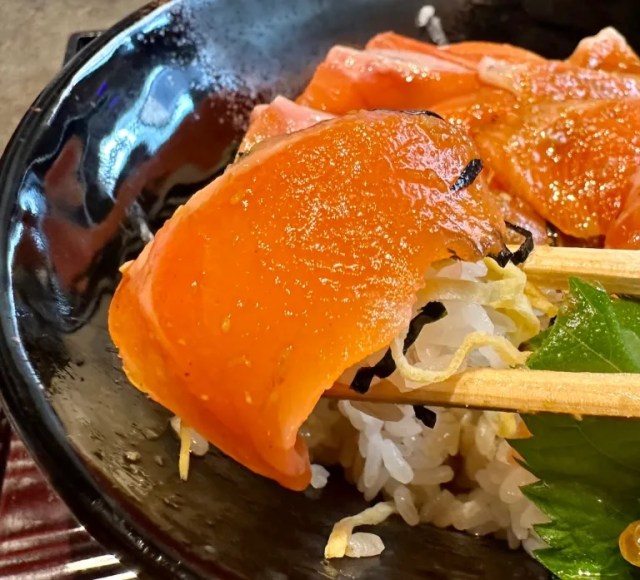
 New train recreates hotel atmosphere with wood interiors and views from the foot of Mount Fuji
New train recreates hotel atmosphere with wood interiors and views from the foot of Mount Fuji Beautiful Red and Blue Star luxury trains set to be Japan’s new Hokkaido travel stars
Beautiful Red and Blue Star luxury trains set to be Japan’s new Hokkaido travel stars Japan now has Mt Fuji bread!
Japan now has Mt Fuji bread! I can’t believe it’s not fish eggs? Taste-testing Japan’s imitation “almost ikura”【Photos】
I can’t believe it’s not fish eggs? Taste-testing Japan’s imitation “almost ikura”【Photos】 Fujisan beer, made with rice grown by water under Mt. Fuji, may have world’s most beautiful can
Fujisan beer, made with rice grown by water under Mt. Fuji, may have world’s most beautiful can Foreigner’s request for help in Tokyo makes us sad for the state of society
Foreigner’s request for help in Tokyo makes us sad for the state of society Bad tourist manners at Mt Fuji Lawson photo spot prompts Japanese town to block view with screens
Bad tourist manners at Mt Fuji Lawson photo spot prompts Japanese town to block view with screens FUK COFFEE?!? Japanese cafe has a perfectly innocent reason for its startling-looking name
FUK COFFEE?!? Japanese cafe has a perfectly innocent reason for its startling-looking name McDonald’s Japan’s new pancake pie is a taste sensation
McDonald’s Japan’s new pancake pie is a taste sensation One of Japan’s oldest castles now lets travelers spend night on the grounds, drink in its keep
One of Japan’s oldest castles now lets travelers spend night on the grounds, drink in its keep Studio Ghibli unveils massive T-shirt collection featuring top anime movie characters
Studio Ghibli unveils massive T-shirt collection featuring top anime movie characters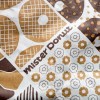 Mister Donut’s new Kyoto roasted green tea donut is a mess…in the best possible way
Mister Donut’s new Kyoto roasted green tea donut is a mess…in the best possible way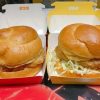 Who wins in a battle of McDonald’s and Komeda Coffee’s chicken tatsuta burgers?【Taste test】
Who wins in a battle of McDonald’s and Komeda Coffee’s chicken tatsuta burgers?【Taste test】 Japanese-style accommodation at the new Premium Dormy Inn hotel in Asakusa will blow your mind
Japanese-style accommodation at the new Premium Dormy Inn hotel in Asakusa will blow your mind Tokyo Tsukiji fish market site to be redeveloped with 50,000-seat stadium, hotel, shopping center
Tokyo Tsukiji fish market site to be redeveloped with 50,000-seat stadium, hotel, shopping center Japanese ramen restaurants under pressure from new yen banknotes
Japanese ramen restaurants under pressure from new yen banknotes McDonald’s new Happy Meals offer up cute and practical Sanrio lifestyle goods
McDonald’s new Happy Meals offer up cute and practical Sanrio lifestyle goods Red light district sushi restaurant in Tokyo shows us just how wrong we were about it
Red light district sushi restaurant in Tokyo shows us just how wrong we were about it New private rooms on Tokaido Shinkansen change the way we travel from Tokyo to Kyoto
New private rooms on Tokaido Shinkansen change the way we travel from Tokyo to Kyoto Japanese city loses residents’ personal data, which was on paper being transported on a windy day
Japanese city loses residents’ personal data, which was on paper being transported on a windy day French Fries Bread in Tokyo’s Shibuya becomes a hit on social media
French Fries Bread in Tokyo’s Shibuya becomes a hit on social media Beautiful Red and Blue Star luxury trains set to be Japan’s new Hokkaido travel stars
Beautiful Red and Blue Star luxury trains set to be Japan’s new Hokkaido travel stars Secret Kitchen bento serves Japanese flowers, birds, wind and moon in a box, but is it worth it?
Secret Kitchen bento serves Japanese flowers, birds, wind and moon in a box, but is it worth it? New definition of “Japanese whiskey” goes into effect to prevent fakes from fooling overseas buyers
New definition of “Japanese whiskey” goes into effect to prevent fakes from fooling overseas buyers Our Japanese reporter visits Costco in the U.S., finds super American and very Japanese things
Our Japanese reporter visits Costco in the U.S., finds super American and very Japanese things All-you-can-drink Starbucks and amazing views part of Tokyo’s new 170 meter-high sky lounge
All-you-can-drink Starbucks and amazing views part of Tokyo’s new 170 meter-high sky lounge More foreign tourists than ever before in history visited Japan last month
More foreign tourists than ever before in history visited Japan last month New Pokémon cakes let you eat your way through Pikachu and all the Eevee evolutions
New Pokémon cakes let you eat your way through Pikachu and all the Eevee evolutions Disney princesses get official manga makeovers for Manga Princess Cafe opening in Tokyo
Disney princesses get official manga makeovers for Manga Princess Cafe opening in Tokyo Studio Ghibli releases Kiki’s Delivery Service chocolate cake pouches in Japan
Studio Ghibli releases Kiki’s Delivery Service chocolate cake pouches in Japan Sales of Japan’s most convenient train ticket/shopping payment cards suspended indefinitely
Sales of Japan’s most convenient train ticket/shopping payment cards suspended indefinitely Sold-out Studio Ghibli desktop humidifiers are back so Totoro can help you through the dry season
Sold-out Studio Ghibli desktop humidifiers are back so Totoro can help you through the dry season Japanese government to make first change to romanization spelling rules since the 1950s
Japanese government to make first change to romanization spelling rules since the 1950s Ghibli founders Toshio Suzuki and Hayao Miyazaki contribute to Japanese whisky Totoro label design
Ghibli founders Toshio Suzuki and Hayao Miyazaki contribute to Japanese whisky Totoro label design Doraemon found buried at sea as scene from 1993 anime becomes real life【Photos】
Doraemon found buried at sea as scene from 1993 anime becomes real life【Photos】 Tokyo’s most famous Starbucks is closed
Tokyo’s most famous Starbucks is closed One Piece characters’ nationalities revealed, but fans have mixed opinions
One Piece characters’ nationalities revealed, but fans have mixed opinions We asked a Uniqlo employee what four things we should buy and their suggestions didn’t disappoint
We asked a Uniqlo employee what four things we should buy and their suggestions didn’t disappoint 12 beautiful Japanese train stations by the sea
12 beautiful Japanese train stations by the sea Stay in a Japanese hotel room…with a train inside it!
Stay in a Japanese hotel room…with a train inside it! Mt Fuji Curry Bread: Worthy of the award and the long waiting list?
Mt Fuji Curry Bread: Worthy of the award and the long waiting list? Newest Japanese vending machine crush: Keikyu’s kimchi vending machine!【Taste test】
Newest Japanese vending machine crush: Keikyu’s kimchi vending machine!【Taste test】 Yaizu: Japan’s best sushi market destination even most foodies in Japan have never heard of
Yaizu: Japan’s best sushi market destination even most foodies in Japan have never heard of Randomly running into a great sushi lunch like this is one of the best things about eating in Tokyo
Randomly running into a great sushi lunch like this is one of the best things about eating in Tokyo Japanese idol concert goes ahead during heavy rain, creates crazy scenes for otaku near Mt Fuji
Japanese idol concert goes ahead during heavy rain, creates crazy scenes for otaku near Mt Fuji Semi-secret Shinjuku sushi lunch is a great way to get your fish fix for cheap in central Tokyo
Semi-secret Shinjuku sushi lunch is a great way to get your fish fix for cheap in central Tokyo Mount Fuji plans to start charging compulsory fee to climbers
Mount Fuji plans to start charging compulsory fee to climbers Get lucky: Survey polls Japanese women about their one-night-only amorous affairs in satin sheets
Get lucky: Survey polls Japanese women about their one-night-only amorous affairs in satin sheets Salmon-flavored Puccho candy – disgusting or delightful? 【Taste test】
Salmon-flavored Puccho candy – disgusting or delightful? 【Taste test】 Japan’s new luxury sightseeing train will show you part of the country most foreigners never see
Japan’s new luxury sightseeing train will show you part of the country most foreigners never see Who’s got the best, cheapest one-person sushi delivery in downtown Tokyo? Mr. Sato investigates!
Who’s got the best, cheapest one-person sushi delivery in downtown Tokyo? Mr. Sato investigates! Our 7 best conveyor-belt sushi restaurants in Sapporo
Our 7 best conveyor-belt sushi restaurants in Sapporo Antinomy: Talking to Urbangarde about their vision, music, and lying to fans
Antinomy: Talking to Urbangarde about their vision, music, and lying to fans
Leave a Reply